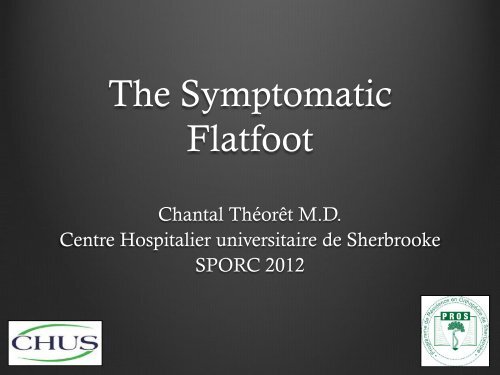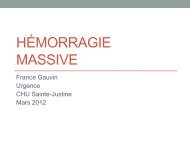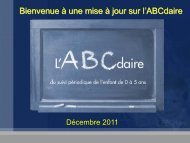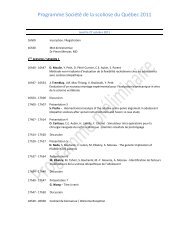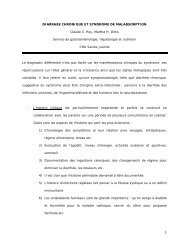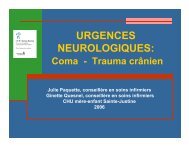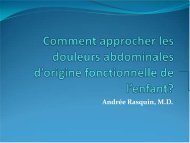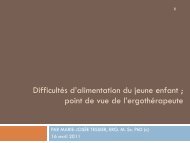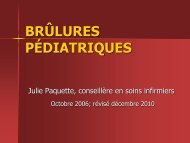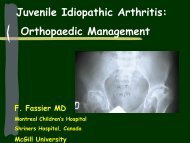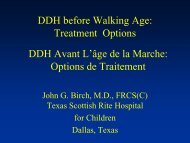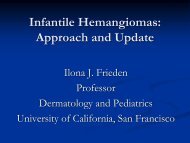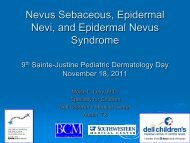Flat foot - CHU Sainte-Justine - SAAC
Flat foot - CHU Sainte-Justine - SAAC
Flat foot - CHU Sainte-Justine - SAAC
Create successful ePaper yourself
Turn your PDF publications into a flip-book with our unique Google optimized e-Paper software.
The Symptomatic<br />
<strong>Flat</strong><strong>foot</strong><br />
Chantal Théorêt M.D.<br />
Centre Hospitalier universitaire de Sherbrooke<br />
SPORC 2012
What is a flat <strong>foot</strong><br />
Low or absent<br />
longitudinal arch of the<br />
<strong>foot</strong> ( mid<strong>foot</strong> sags in a<br />
plantar direction)<br />
Valgus hind<strong>foot</strong><br />
Supinated fore<strong>foot</strong><br />
SPORC 2012
Flexible <strong>Flat</strong><strong>foot</strong><br />
Common (incidence unknown)<br />
Familial<br />
No agreement on<br />
strict clinical or<br />
radiographic criteria<br />
Rarely painful/disabling<br />
SPORC 2012<br />
Generates interest,<br />
investigation and<br />
controversy
Flexible <strong>Flat</strong><strong>foot</strong><br />
Plantar arch develops in the<br />
first decade<br />
Incidence flat<strong>foot</strong><br />
age<br />
Bone-ligament complex<br />
determines the height of<br />
the longitudinal arch<br />
2/3 asymptomatic flexible<br />
flatfeet<br />
Staheli,LT J Bone Joint Surg AM 1987<br />
SPORC 2012
Asymptomatic FFF<br />
Clinical features:<br />
• The arch elevates with toe<br />
standing and the heel corrects<br />
from valgus to varus<br />
• Toe-raise test, the arch elevates<br />
because of the windlass effect<br />
of the plantar fascia<br />
SPORC 2012
Asymptomatic FFF<br />
• Achilles tendon tightness:<br />
dorsiflexion <strong>foot</strong> with knee<br />
extended and hind<strong>foot</strong><br />
inverted<br />
• Mobility subtalar joint<br />
• Callosities head talus<br />
• Generalized ligamentous<br />
laxity<br />
• Torsional and angular<br />
deformity (genu valgum)<br />
General examination<br />
(gait, spine r/o<br />
neuromuscular disease<br />
or syndrome)<br />
SPORC 2012
Asymptomatic FFF<br />
Natural history:<br />
• Spontaneous resolution in most cases<br />
( 20% adult have flatfeet)<br />
• Anatomic variant and not a disabling<br />
deformity<br />
No treatment<br />
Randomized control studies reveal no benefit<br />
from shoe modification and insert compared to<br />
normal development<br />
Wenger DR, J Bone Joint Surg Am 1989<br />
SPORC 2012
Normal developmental vs<br />
Pathologic form of flat <strong>foot</strong><br />
Pain<br />
Rigid flat<strong>foot</strong>: Rom ankle or subtalar joint<br />
SPORC 2012
Symptomatic flat<strong>foot</strong><br />
Flexible: - Physiologic or developmental (FFF)<br />
- Short Achilles tendon (STA)<br />
25%<br />
- Calcaneovalgus <strong>foot</strong><br />
- Accessory navicular<br />
Rigid:<br />
- Tarsal coalitions<br />
- Congenital vertical talus<br />
- Neuromuscular diseases<br />
Harris and Beath<br />
9 % all flatfeet<br />
- JIA<br />
Syndromes ( Marfans, Ehler-Danlos, Trisomy 21) flexible or rigid<br />
SPORC 2012
Physiologic FFF with pain<br />
Radiographic evaluation:<br />
Weight-bearing AP and LAT<br />
Talo-first MTT,<br />
TN coverage<br />
Angles*<br />
Talo-first MTT angle<br />
Calcaneal pitch<br />
SPORC 2012
Physiologic FFF with pain<br />
Oblique and Harris views<br />
if rigid flat<strong>foot</strong><br />
( r/o coalition)<br />
SPORC 2012
Physiologic FFF with pain<br />
Some children can have activity-related pain or fatigue<br />
Remains unclear why some flatfeet become symptomatic<br />
More common in overweight children<br />
Treatment : soft over-the counter or firm custom-molded<br />
orthoses can decrease symptoms<br />
SPORC 2012
FFF and Short Achilles tendon<br />
Much more likely to cause<br />
pain then simple FFF<br />
Treatment: Soft tissues<br />
- Stretching program<br />
Drennan’s<br />
2nd edition<br />
(physiotx)<br />
- Heel cord lengthening vs<br />
gastrocnemius recession<br />
SPORC 2012<br />
Lovell and Winter’s
FFF and Short Achilles tendon<br />
Surgical treatment<br />
Indication<br />
Retrospective study 135 patients 3 groups<br />
JPO june 2011 Moraleda and Mubarak<br />
Only AP TALONAVICULAR COVERAGE<br />
seemed to be related to the onset of symptons<br />
Rare painful<br />
adolescent who has<br />
failed prolonged<br />
conservative treatment<br />
SPORC 2012
Surgical options<br />
Osteotomies<br />
- medially translation calcaneal tuberosity<br />
- calcaneal lengthening (Evans/Mosca)<br />
Arthroereisis<br />
Arthrodesis<br />
SPORC 2012
FFF and Short Achilles tendon<br />
Medial displacement<br />
osteotomy of the<br />
calcaneum<br />
correct malalignement subtalor<br />
joint, but creates compensating<br />
deformity to improve valgus heel<br />
SPORC 2012
FFF and Short Achilles tendon<br />
Calcaneal lengthening<br />
osteotomy (Evans/Mosca)<br />
- Medial plication<br />
talonavicular joint capsule/tib post<br />
- Achilles tendon lengthening<br />
- Plantar base closing wedge<br />
osteotomy medial cuneiform<br />
( fixed supination )<br />
Tricortical iliac bone graft trapezoid-shaped<br />
between ant and middle facets<br />
SPORC 2012
FFF and Short Achilles tendon<br />
Pre-op planovalgus <strong>foot</strong><br />
SPORC 2012<br />
Post-op
FFF and Short Achilles tendon<br />
Arthroereisis<br />
(pseudoarthrodesis)<br />
- Restrict excessive eversion<br />
subtalar joint implant<br />
( metal or bioabsorbable)<br />
- Long-term studies needed before<br />
recommending this<br />
procedure<br />
Arthrodesis: very rare<br />
Only if degenerative changes<br />
SPORC 2012
Calcaneovalgus <strong>foot</strong><br />
Hyperdorsiflexed <strong>foot</strong><br />
(dorsal <strong>foot</strong> resting on the<br />
anterior tibia)<br />
Very common in infancy<br />
Intrauterine malposition<br />
( girls and first born)<br />
SPORC 2012
Calcaneovalgus <strong>foot</strong><br />
Flexible in plantar flexion<br />
and inversion<br />
R/O :<br />
- Paralytic <strong>foot</strong> ( spina bifida)<br />
- Posteromedial bowing tibia<br />
- Congenital vertical talus<br />
Spontaneous resolution within 3<br />
to 6 months in most cases<br />
SPORC 2012
Accessory navicular<br />
Plantar medial enlargement of the tarsal navicular beyond its<br />
normal size (may be associated with flat<strong>foot</strong>)<br />
Most common accessory bone in the <strong>foot</strong><br />
Incidence from 4 to 14%<br />
Often bilateral<br />
More common in girls<br />
Autosomal dominant pattern<br />
SPORC 2012
Accessory navicular<br />
Clinical evaluation<br />
- active adolescent with a flexible flat<strong>foot</strong><br />
- pain and/or swelling on the medial side mid<strong>foot</strong><br />
- pain with resisted inversion<br />
SPORC 2012
Accessory navicular<br />
Lovell and<br />
Winter’s<br />
6th edition<br />
SPORC 2012<br />
Type 1<br />
Sesamoid bone<br />
within post<br />
tibialis tendon<br />
Type 2<br />
Bullet-shaped ossicle<br />
joined to the navicular<br />
by a synchondrosis<br />
Type 3<br />
Large horn- shaped<br />
navicular<br />
(fusion type 2)
Accessory navicular<br />
Conservative treatment: - decrease direct pressure<br />
- decrease stress from post tibialis<br />
tendon<br />
- Soft shoe with doughnut-shaped<br />
pad around the navicular to decrease pressure<br />
- Short leg walking cast<br />
- arch support can aggravate pain<br />
SPORC 2012
Accessory navicular<br />
Surgical treatment:<br />
- Simple excision ossicle and the prominent portion navicular<br />
through a tendon-splitting approach ( 90% good results)<br />
*Kidner procedure (advanced tibialis post tendon plantarly)<br />
No benefit<br />
- Percutaneous drilling type 2 ( effective in young athletes )<br />
SPORC 2012
Tarsal coalition<br />
Fibrous, cartilaginous or bony connection between two or<br />
more bones of the hind<strong>foot</strong> and mid<strong>foot</strong>.<br />
Incidence: from 2.9 to 5.6%<br />
Sites: - Talocalcaneal joint ( middle facet)<br />
- Calcaneonavicular<br />
90%<br />
*50-60% bilateral<br />
SPORC 2012
Tarsal coalition<br />
Natural history:<br />
25 % become symptomatic<br />
WHY: 1. stress fracture at a time of ossification<br />
- 8-12 years old for calcaneonavicular<br />
- 12-16 years old for talocalcaneal<br />
2. limited motion causes increased stress across<br />
adjacent joints<br />
SPORC 2012
Tarsal coalition<br />
Physical examination:<br />
- Pain ( medial or in the sinus tarsi) with valgus hind<strong>foot</strong> and rigid<br />
flat<strong>foot</strong><br />
- pain aggravated by activity and relieved by rest<br />
- limited subtalar motion<br />
- ankle sprains are common<br />
SPORC 2012
Tarsal coalition<br />
X-ray:<br />
Calcaneonavicular coalition<br />
- oblique x-ray of the <strong>foot</strong> - lateral x-ray:<br />
anteater<br />
nose sign<br />
SPORC 2012
Tarsal coalition<br />
Talocalcaneal coalition:<br />
Talar beak<br />
- lateral view<br />
C-sign ( non specific)<br />
Dorsal talar beak<br />
(traction spur, not degenerative)<br />
- Harris view<br />
- Ct-scan or MRI<br />
r/o other coalition<br />
SPORC 2012
Tarsal coalition<br />
Conservative treatment:<br />
• Activity modification<br />
• Antiinflammatory drugs<br />
• shoe inserts<br />
• Below-knee walking cast<br />
(30% pain free 6 weeks after<br />
cast removal )<br />
SPORC 2012
Tarsal coalition<br />
Surgical treatment:<br />
- resection of the coalition<br />
Calcaneonavicular coalition<br />
Resection and Interposition<br />
- osteotomy ( correct valgus)<br />
- arthrodesis<br />
(degenerative arthrosis)<br />
extensor<br />
digitorum<br />
brevis<br />
Contraindication to resection:<br />
Significant degenerative changes<br />
(not talar beak)<br />
Lovell and<br />
Winter’s<br />
SPORC 2012
Tarsal coalition<br />
Talocalcaneal coalition<br />
- Resection and interposition<br />
(located on the medial side,<br />
resection may lead to collapse in<br />
valgus)<br />
Lovell and<br />
Winter’s<br />
- Poorer outcome if:<br />
- valgus deformity<br />
- coalition > 50% area<br />
posterior facet<br />
Interposition:<br />
fat or split portion of FHL<br />
SPORC * 2012
Take home message<br />
2/3 FFF are asymptomatic<br />
Asymptomatic FFF anatomic variant ( no treatment)<br />
Recognize pathologic painfull and/or rigid flafeet.<br />
Weight bearing x-rays<br />
Conservative treatment<br />
SPORC 2012
SPORC 2012


